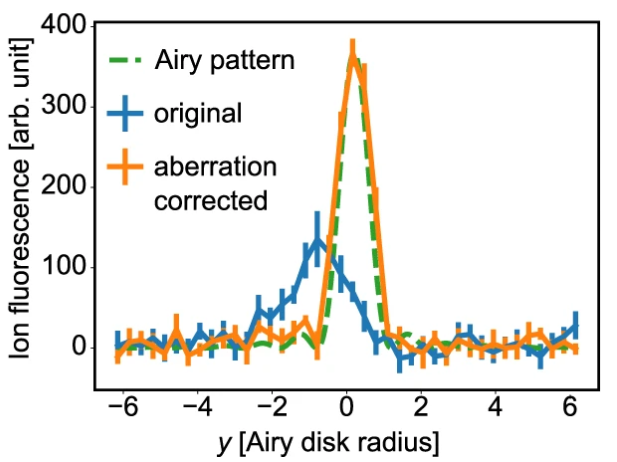2021
Reprogrammable and high-precision holographic optical addressing of trapped ions for scalable quantum control
Chung-You Shih, Sainath Motlakunta, Nikhil Kotibhaskar, Manas Sajjan, Roland Hablützel, Rajibul Islam

We demonstrate programmable, holographic optical addressing of trapped Yb+ at λ=369 nm. Using the ion as a sensor, we characterize the total optical aberrations in the entire beam path. We then compensate for the aberration by feeding back onto the hologram, such that the residual aberration at the ion is about λ/20, which is smaller than specifications for individual commercial optic. Using an iterative Fourier transform algorithm to generate the holograms, we can suppress relative intensity `crosstalk’ errors to below < 10−4 at a few micrometers away while addressing arbitrary sets of ions. Our results are among the highest quality optical addressing of trapped ions.
Abstract: High-precision, individually programmable manipulation of quantum particles is crucial for scaling up quantum information processing (QIP) systems such as laser-cooled trapped-ions. However, restricting undesirable “crosstalk” in optical manipulation of ion qubits is fundamentally challenging due to micron-level inter-ion separation. Further, inhomogeneous ion spacing and high susceptibility to aberrations at UV wavelengths suitable for most ion-species pose severe challenges. Here, we demonstrate high-precision individual addressing (λ = 369.5 nm) of Yb+ using a reprogrammable Fourier hologram. The precision is achieved through in-situ aberration characterization via the trapped ion, and compensating (to λ/20) with the hologram. Using an iterative Fourier transformation algorithm (IFTA), we demonstrate an ultra-low (<10−4) intensity crosstalk error in creating arbitrary pair-wise addressing profiles, suitable for over fifty ions. This scheme relies on standard commercial hardware, can be readily extended to over a hundred ions, and adapted to other ion-species and quantum platforms.